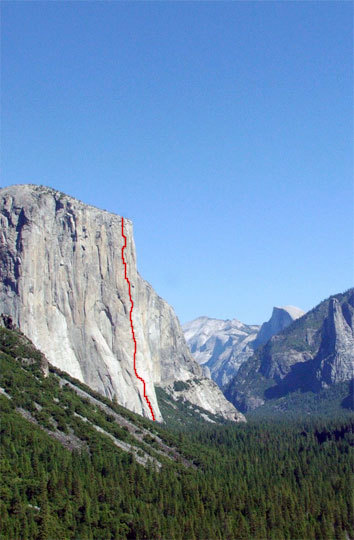
El Capitan, showing the approximate free line of Magic Mushroom (VI 5.14, ca. 2,900′, Caldwell-Sjong, 2008). Tommy Caldwell and Justen Sjong freed the route in a push from May 12–17. The route features eleven 5.13 to 5.14 pitches and nine 5.12 to 5.12+ pitches, making it the hardest, most sustained bigwall free climb in the world. [Photo] Luke Bauer
In the past twenty-four hours more details have emerged about the first free ascent of Magic Mushroom (VI 5.7 A3, 2,900′, the El Cap aid line to the left of the Nose that was established by Hugh Burton and Steve Sutton in 1972 and freed by Tommy Caldwell and Justen Sjong in a five-day push from May 12-17 at 5.14.
The route had first been suggested to Caldwell and Sjong by their mutual friend, Adam Stack, who had worked on freeing it for some two years. Stack had figured out most of the moves and the actual line the free route should take three years ago but had been unable to free it. He told the pair there was nothing he’d like better than for the two of them to do it together. Though Caldwell and Sjong had spent time hanging out on top of El Cap during their efforts on various free routes, Magic Mushroom marked the first time they had climbed together.
After working the route for five weeks, Caldwell and Sjong began their free ascent on May 12 at 5 a.m. Climbing ground up in a push, they each freed every pitch, swinging leads. The route is reported as very high quality, and very steep: the top twelve pitches overhang the entire way. Though the 5.14a crux of the Dihedral Wall (VI 5.8 A3, Baldwin-Cooper-Denny, 1962), which Caldwell freed at 5.14a in 2005, is perhaps more difficult than any single move on Magic Mushroom, Magic Mushroom is far more sustained, with eleven 5.13 or 5.14 pitches and nine 5.12 to 5.12+ pitches.
The route featured technical chimney climbing that maxed out the rubber on their shoes and wore away the skin on their backs. Sjong was reported to have had gaping wounds on his back from rubbing up “miles” of flared climbing.
Magic Mushroom was the third route Caldwell had climbed in a push: he did the Salathe Wall in a day in 1998, and the Dihedral Wall in a push in 2005. His approach to freeing routes on El Cap has evolved: when he began he believed it was acceptable to return to the ground during free attempts as long as the pitches were climbed in the proper order. Magic Mushroom represents his current standard: free routes should be climbed ground up in a single push.
Caldwell believes the first free ascent of Magic Mushroom parallels the evolution of climbing on El Cap in general. Fifty years ago, when Warren Harding, Wayne Merry and George Whitmore completed the first ascent of the Nose, climbers sought out the major weaknesses on the wall. In the 1970s the emphasis turned to the harder aid lines, ones that linked together less prominent features. In 1988, when Todd Skinner and Paul Piana made the first free ascent of the Salathé Wall, the focus turned to free climbing El Cap by the major weaknesses again—i.e., the classic, easier aid routes.
Even so, Magic Mushroom represented an evolution of its own. In its effort to climb new ground, the aid route took more of a meandering path. The free version, which adheres only 60 or 70% to the original route, takes a line more logical to free climbers. The result is a much straighter, more direct line. “It pretty much goes straight up the wall,” said a source familiar to the climb.